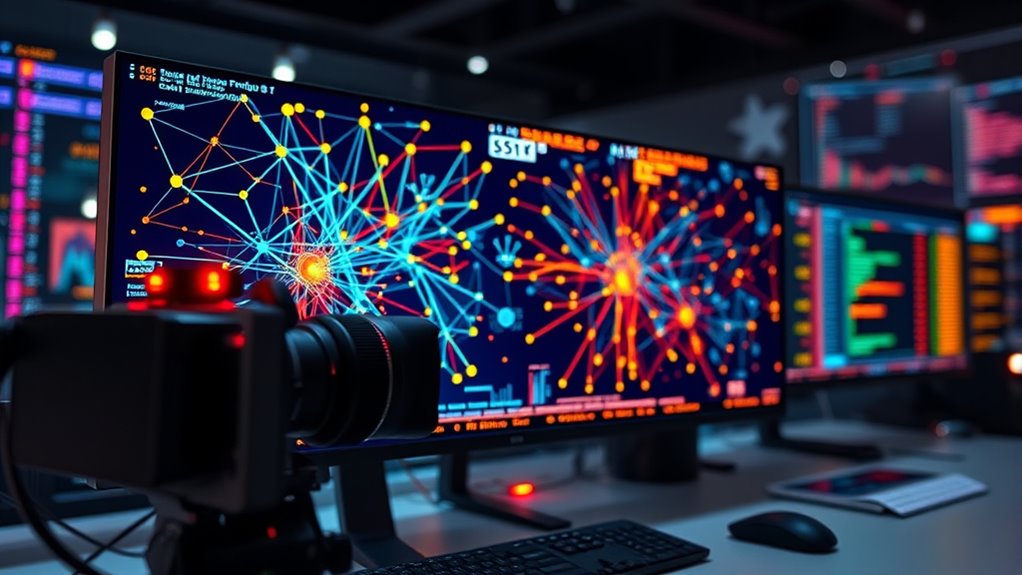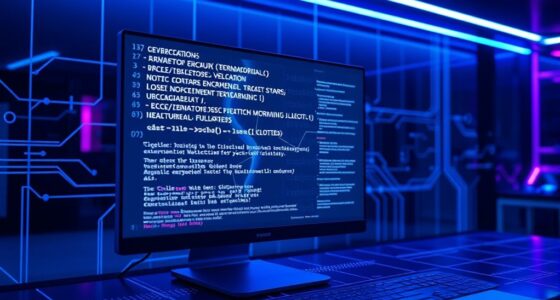AI-driven cybersecurity threat hunting enhances your defenses by analyzing vast amounts of data in real time, helping you spot hidden malicious activities that traditional tools often miss. It identifies subtle attack patterns, detects insider threats, and adapts to emerging threats using behavioral analytics and threat intelligence. This proactive approach automates repetitive tasks and shortens response times, allowing you to stay ahead of cybercriminals. Keep exploring to discover how these advanced strategies can strengthen your security posture even further.
Key Takeaways
- AI-driven threat hunting analyzes large data sets in real-time to identify subtle and emerging cyber threats.
- Behavioral analytics establish normal activity patterns to detect anomalies indicating potential security breaches.
- Integration of threat intelligence provides up-to-date attack signatures and tactics for proactive defense.
- Combining behavioral analytics with threat intel automates detection, reducing response times and enhancing accuracy.
- AI-powered threat hunting shifts cybersecurity from reactive to proactive, enabling early threat identification and mitigation.

As cyber threats become more sophisticated, organizations are turning to AI-driven threat hunting to stay ahead of attackers. Traditional security measures often rely on static rules and signature-based detection, which can miss novel or subtle attack patterns. By leveraging AI, you gain the ability to analyze vast amounts of data in real-time, uncovering malicious activity that would otherwise go unnoticed. Central to this approach are behavioral analytics and threat intelligence, which work together to identify anomalies and predict potential breaches before they escalate.
Harness AI-driven threat hunting with behavioral analytics and threat intelligence to detect and prevent sophisticated cyber attacks early.
Behavioral analytics enables you to establish a baseline of normal user activity, device behavior, and network traffic. When AI systems monitor ongoing activity, they can detect deviations from these established norms. For instance, if a user suddenly accesses sensitive data at unusual hours or downloads large volumes of information, the AI flags this as suspicious. This proactive detection helps you spot insider threats, compromised accounts, or advanced persistent threats early. The ability to understand context and behavioral patterns makes AI-driven threat hunting more precise and less prone to false positives than traditional methods.
Threat intelligence complements behavioral analytics by providing you with up-to-date information on known attack vectors, malware signatures, and attacker tactics. When integrated into AI systems, threat intelligence feeds enable real-time insights into emerging threats. This means your security tools can automatically adjust and prioritize alerts based on the latest intelligence, reducing your response time. For example, if a new malware strain is identified, the AI can recognize indicators of compromise associated with it and hunt for similar activity within your environment. This dynamic, intelligence-driven approach ensures your defenses evolve alongside the threat landscape.
By combining behavioral analytics with threat intelligence, AI-driven threat hunting becomes a continuous and adaptive process. Instead of waiting for alerts from static rules, you proactively seek out signs of compromise, even when attackers employ evasive techniques. This approach empowers you to automate repetitive tasks, such as log analysis and pattern recognition, freeing your security team to focus on strategic incident response. Furthermore, AI’s ability to learn from new data means your threat detection capabilities improve over time, adapting to changing attack methods and reducing blind spots.
In essence, AI-driven threat hunting transforms cybersecurity from a reactive to a proactive discipline. With behavioral analytics and threat intelligence working in tandem, you gain a powerful advantage against cyber adversaries—one that detects threats early, responds swiftly, and continuously enhances your defenses against an ever-evolving threat landscape. Incorporating raw data analysis can further improve detection accuracy by leveraging unprocessed information to uncover hidden attack patterns.
Frequently Asked Questions
How Does AI Identify Zero-Day Threats?
You might wonder how AI detects zero-day threats. It uses behavioral analysis to understand normal system activity and anomaly detection to spot unusual patterns that could indicate new, unseen threats. By continuously monitoring and analyzing data, AI identifies deviations from typical behavior, flagging potential zero-day exploits early. This proactive approach helps you respond swiftly before attackers can cause significant harm, making your cybersecurity defenses more robust.
What Are the Privacy Concerns With AI Cybersecurity Tools?
Your privacy is at stake with AI cybersecurity tools—these systems analyze massive amounts of data, raising serious Data privacy concerns. You might worry about sensitive info being exposed or misused. Plus, bias mitigation is essential; if algorithms aren’t carefully managed, they can unfairly target or overlook threats. Staying aware helps you protect your data and guarantee AI tools work fairly, keeping your digital world safe without sacrificing privacy.
Can AI Completely Replace Human Cybersecurity Analysts?
You might wonder if AI can fully replace human cybersecurity analysts. While AI enhances threat detection and response, it can’t fully manage complex decision-making or ethical considerations. AI ethics emphasize the importance of human oversight to guarantee responsible use. You need human judgment for nuanced situations, making AI a powerful tool rather than a complete replacement. Human analysts bring contextual understanding that AI alone can’t provide, maintaining a balanced cybersecurity approach.
How Does AI Adapt to Evolving Cyberattack Tactics?
You might think AI can’t keep up with evolving cyberattack tactics, but it actually adapts through behavioral analysis and threat intelligence. As hackers change their methods, AI learns from new patterns, constantly updating its models. This ongoing process helps AI identify emerging threats faster than humans alone. So, with continuous learning, AI stays one step ahead, effectively countering new tactics and enhancing your cybersecurity defenses.
What Are the Costs Associated With Implementing AI Threat Hunting?
When considering AI threat hunting, you should do a thorough cost analysis to understand the expenses involved. Implementing AI tools requires significant investment in technology, infrastructure, and skilled personnel. You need to factor in ongoing maintenance and updates. Budget considerations are vital, as AI solutions can be costly upfront, but they often save money long-term by reducing the risk of cyberattacks and minimizing incident response costs.
Conclusion
So, as you rely more on AI to hunt threats, remember—you’re trusting a machine to outsmart cybercriminals. Ironically, the very tools designed to protect you could become the vulnerabilities if not carefully managed. While AI can spot patterns faster than you can blink, it’s still no substitute for human intuition. In this high-tech game, don’t forget: the smartest move might just be staying one step ahead of the AI itself.








